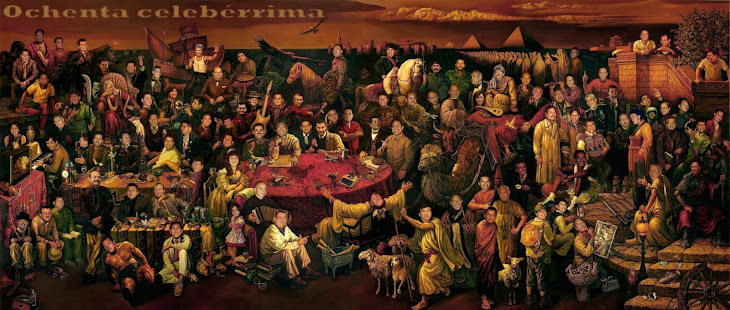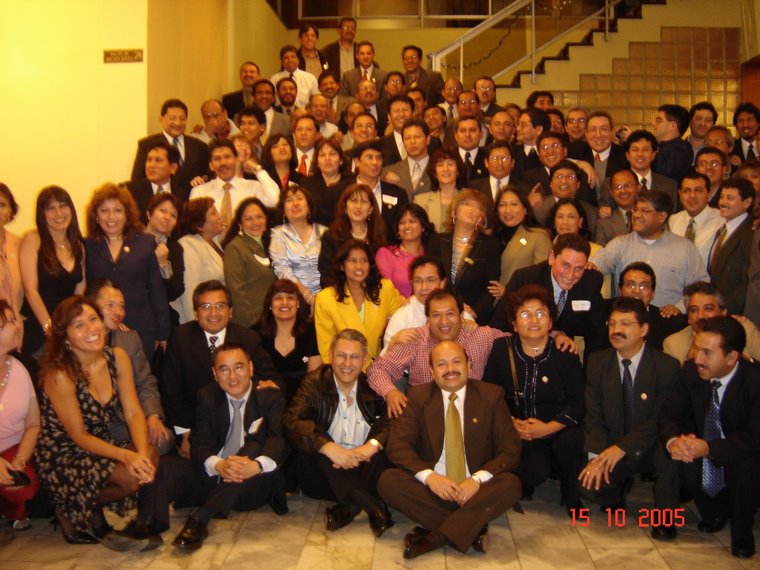 CARAL : la "ciudad madre" --- flautas, caracoles, coca ........
CARAL : la "ciudad madre" --- flautas, caracoles, coca ........La magnífica ciudad de pirámides en Caral, Perú, fue noticia en el 2001, cuando se descubrió que era la más antigua de América y, datando de 2.627A.C., tan vieja como las pirámides de Egipto. Ahora, muchos creen que es un mítico eslabón perdido de la arqueología: una "ciudad madre". De ser cierto, podría finalmente proveer la respuesta a una de las grandes preguntas de la arqueología: ¿por qué los humanos se civilizaron? La civilización empezó en sólo seis áreas del mundo: Egipto, Mesopotamia, India, China, Perú y Centro América. En cada una de estas regiones, la gente pasó de vivir en pequeñas unidades familiares a construir ciudades de miles de personas.
¿Por qué? Para encontrar la respuesta, los arqueólogos tenían que encontrar primero algo que han estado buscando por un siglo: la primera fase de construcción de una ciudad. Pero, las civilizaciones constantemente reconstruyen sobre lo existente: en todas partes, esa primera fase parecía haber sido destruida o lo nuevo la había borrado. A falta de pruebas, surgieron teorías. Algunos postularon que la civilización llegó con el desarrollo del comercio, otros con la irrigación.
Sin embargo, poco a poco se llegó a un incómodo consenso: la teoría de que fue el miedo a la guerra lo que motivó a los humanos a dejar la vida sencilla y formar sociedades complicadas. Para probarlo, los expertos todavía necesitaban una ciudad madre.
Cuando la arqueóloga Ruth Shadi redescubrió su ciudad de pirámides de 5.000 años en el desierto peruano, toda la atención se volcó hacia el Nuevo Mundo. La extraordinaria ciudad de Caral es más antigua que cualquier otra en América y una obvia candidata para ser "ciudad madre" -pues no sólo está en su estado puro, sino que además nada ha sido construido sobre ella. Caral le presenta al mundo un elaborado complejo de pirámides, templos, un anfiteatro y simples casas. Pero lo que es crucial es que no hay ni la más mínima señal de guerra: ni batallas, ni armas, ni cuerpos mutilados.
Lo que se ha encontrado son las huellas de una sociedad amable y apacible, basada en el comercio y el placer. Quizás esa sea la verdadera herencia de Caral: la civilización no nació de batallas y sangre; la guerra empezó a formar parte de la historia humana mucho más tarde; la paz puede producir grandes cosas. Una antigua ciudad encontrada hace un siglo en lo que ahora es Perú fue construida al mismo tiempo que las pirámides de Egipto, reveló un grupo de arqueólogos. El asentamiento de Caral, en el Valle de Supe, fue descubierto en 1905 por el arqueólogo peruano Max Uhle. Pero el hallazgo no fue considerado significativo, porque no se encontraron restos de cerámicas y otros artefactos característicos de civilizaciones avanzadas.
The Mother City: of Flutes, Cocaine and Snails
Along the desert coast of Peru, in an area as desolate as ancient Eridu in Iraq, there were stories of unexplained mounds. While Pozorski was doing his digs at Casma, archaeologist Ruth Shady Solis set out by herself into these dead lands to investigate. In 1994 Dr. Solis found six large dunes on a terrace of land above the Supe River whose headwaters are in the Andes. She soon realized she was looking at the remnants of pyramids. And all around there was was evidence of other smaller buildings and complexes.
Dr. Solis returned to the site now known as Caral in 1996 to begin a more systematic dig with a support team of archaeologists sponsored by Universidad Nacional Mayor de San Marcos. However the team found itself quickly overwhelmed by the 160 acre site when the university cut the team down to three members due to financial problems.
As Solis has been noted as saying, "It's very difficult because in Peru, there is no political culture that favors archaeological investigation. Archaeologists find themselves isolated."
The search for pottery began, the tried and true method to enable fixing a historical date. However they quickly ran into a problem. There was no pottery.
The next step was to dig into the pyramids. To do this though they needed extra help, so the Peruvian government was convinced to lend 25 soldiers. With the extra manpower the team was finally able to move the thousands of tons of dirt and rubble that had gathered over the millenia. Eventually they found the original foundations, and more importantly reeds.
Why were the reeds important? The reeds were still interwoven together in a way indicating that they were part of shicra bags, bags that had been used by the laborers to move the stones from the mountains and is a known Peruvian building technique. The reeds could be carbon dated and a date could finally be determined for the age of Caral.
Samples were taken to the University of Illinois for testing. When the results came in, they were older than anyone expected. The shicra bags were dated to 2600 BC. The people in the Supe Valley of Peru had begun building a city around the time the Sumerians were developing writing and before the Great Pyramid of Giza had been built. Caral is the oldest site in the Americas. Caral is an archaeologists dream. The mother city. And it might even be older as Solis argues, because the reed samples carbon dated did not come from the oldest excavations.
The city of Caral was built and inhabited from 2670BC to 1977 BC, a more than 600 year span. Dominating everything was the main pyramid with five smaller ones arrayed around a central plaza. Circular sunken plazas were found next to two of the pyramids, a feature that would be used over and over again until the time of the Incas. There was also an amphitheatre and a temple that may have had an eternal flame. Evidence of houses, both ornate and simple has been found in the central plaza.
This positive establishment of Caral as a definitive mother city and civilization for the Americas brought Jonathan Haas running... you remember his warfare theory claims that the genesis of civilization is based on fear.
"...warfare causes people to come together for protection creating new ways of societal organization and leadership. So far in every early civilization examined by Haas there have been the trademark signs of violence."
But the warfare theory failed. As Haas noted on the Discovery Channel special of Caral broadcast last month,
"...If I was an approaching army that's where I'd come (a narrow pass into the valley) and that's where I should find defensive fortifications. There should be a wall going across it. They're easy places to put walls across all of these access routes. There should be something to slow down the enemy and in fact there's nothing. There are no fortifications round any of these sites.
"You seemed to really have the beginnings of that complex society and I'm able to look at it right at the start and I look for the conflict and I look for the warfare, I look for the armies and the fortifications and they're not there. They should be here and they're not and you have to change your whole mind-set about the role of warfare in these societies and so it's demolishing our warfare hypothesis. The warfare hypothesis just doesn't work."
It is a definite possibility that the people of Caral were the primal crunchies, the forerunners of all granolas. Regardless of modern biases, it does appear that the mother city was not raised out of fear, but rather out of cooperative impulses. The megabolinus snail, the achiote plant and the condor bones are not indigenous to the Supe Valley. They would have been imported from either the coastal regions or the mountain regions.
The Supe River Valley is a desolate spot in our time, but based on the evidence of irrigation ditches that crisscross the valley, it was by design a fertile land. What made Caral a trade centre and turned it into an importer of exotic goods was cotton. Cotton was used for clothing and it was also used for fishing nets. The maritime people of the central coast of Peru traded fish for the cotton nets and a mercantile system was born.
Eventually Caral's time passed and Casma became the ascendant culture of Peru. Why? Caral could have failed through the vagaries of El Nino, (for once I won't blame it on a full blown terrestrial catastrophe, no evidence.) Most probably it waned or was absorbed as the Sumerians were absorbed by the more militant Akkadians, who adopted the trappings of the civilization they replaced. In time where pyramids and temple complexes stood, only the desert remained.
Update:
Archaeologists, including Jonathan Haas have continued their work since this article was written.
As reported in the December 2004 issue of Nature; there existed an urban infrastructure of up to twenty proto-cities extant not only in the Supe valley, but also in the nearby Patilvica and Fortaleza vallies.
This civilization is now called the Andean and appears to have been far more extensive and older than originally thought. Starting around 3000 BC, this society based on cotton farming and trade, supported by the fishing villages of the coastal regions, thrived for over 1,200 years.
"There wasn't anything like this in the world as far as I can tell," Haas said in an interview with the Seattle Times.
As reported in the December 2004 issue of Nature; there existed an urban infrastructure of up to twenty proto-cities extant not only in the Supe valley, but also in the nearby Patilvica and Fortaleza vallies.
This civilization is now called the Andean and appears to have been far more extensive and older than originally thought. Starting around 3000 BC, this society based on cotton farming and trade, supported by the fishing villages of the coastal regions, thrived for over 1,200 years.
"There wasn't anything like this in the world as far as I can tell," Haas said in an interview with the Seattle Times.













No hay comentarios.:
Publicar un comentario